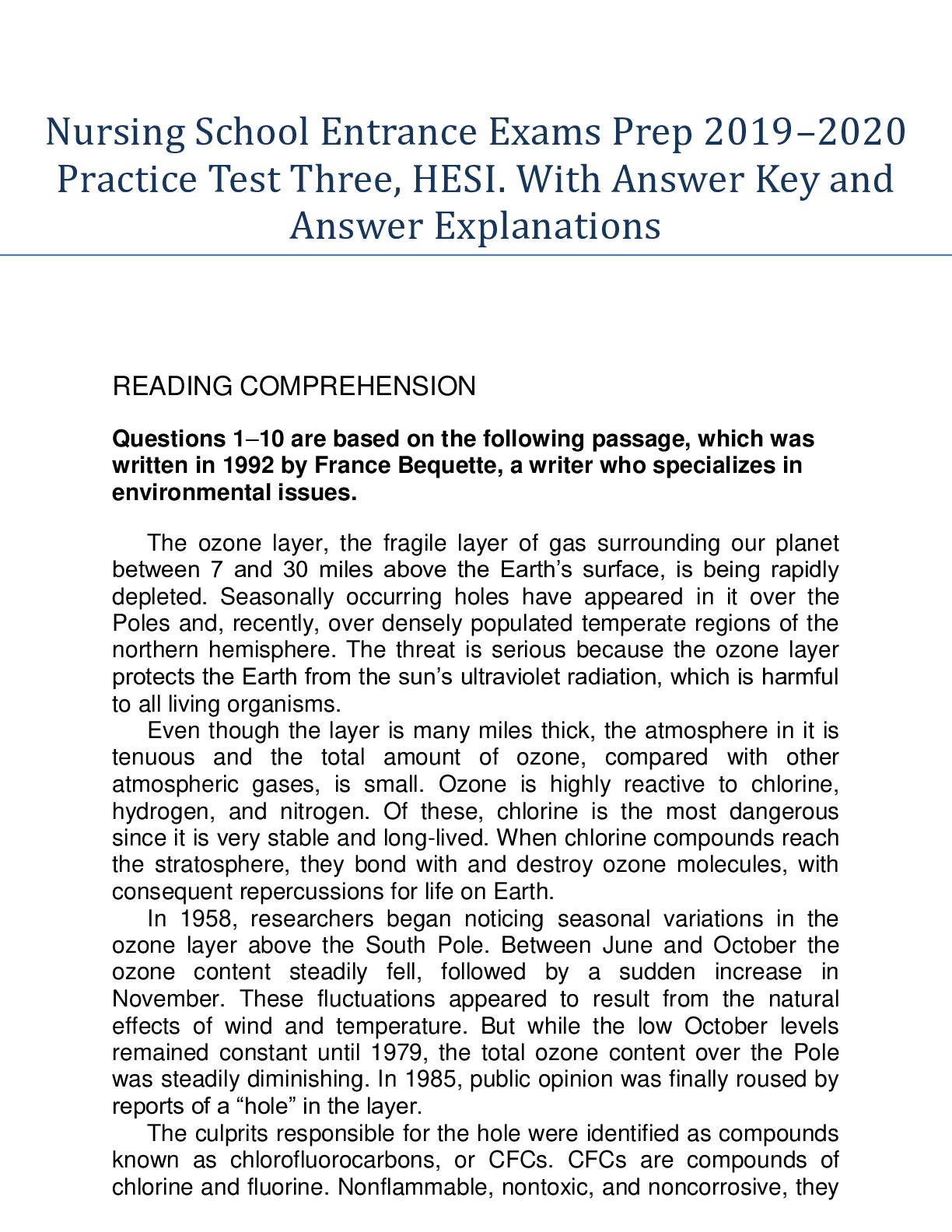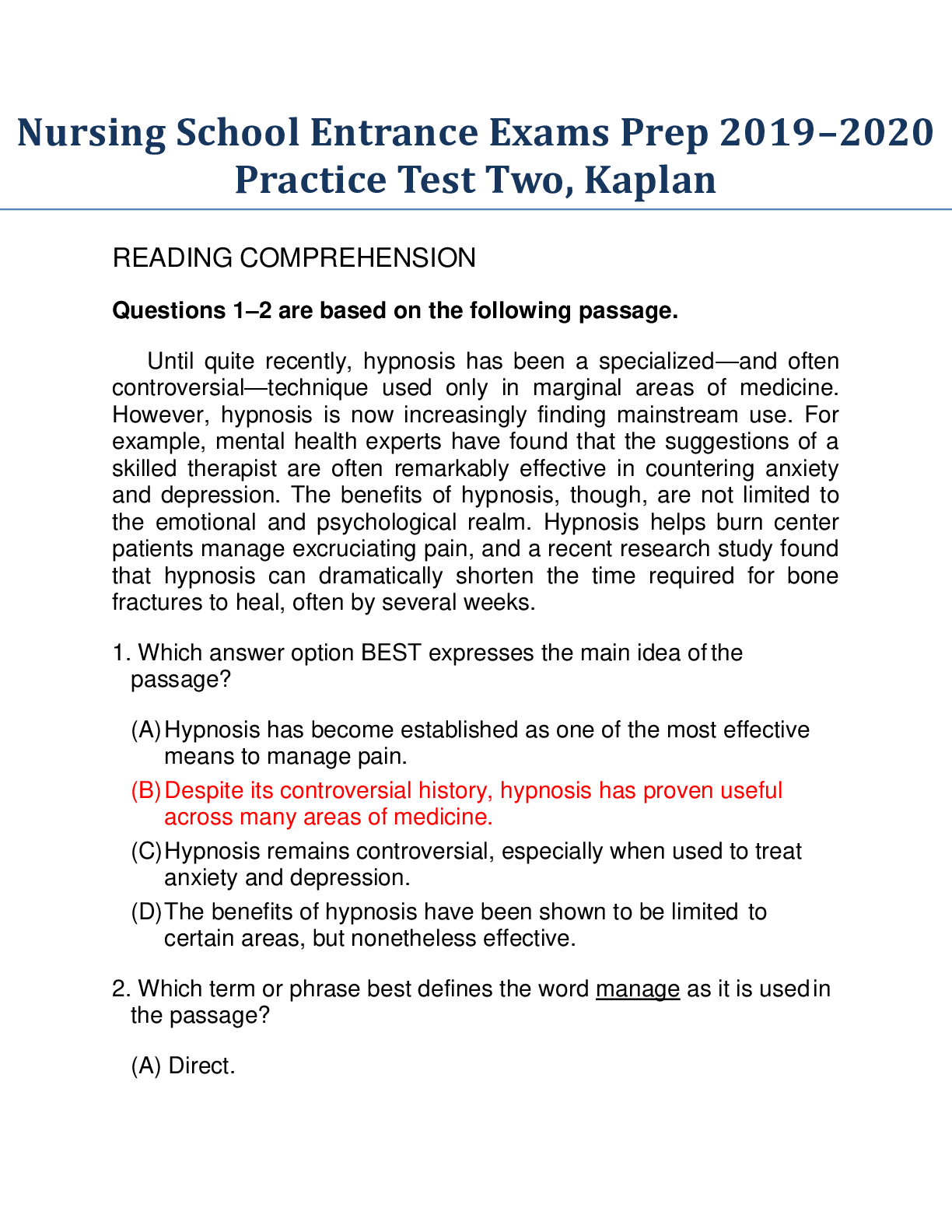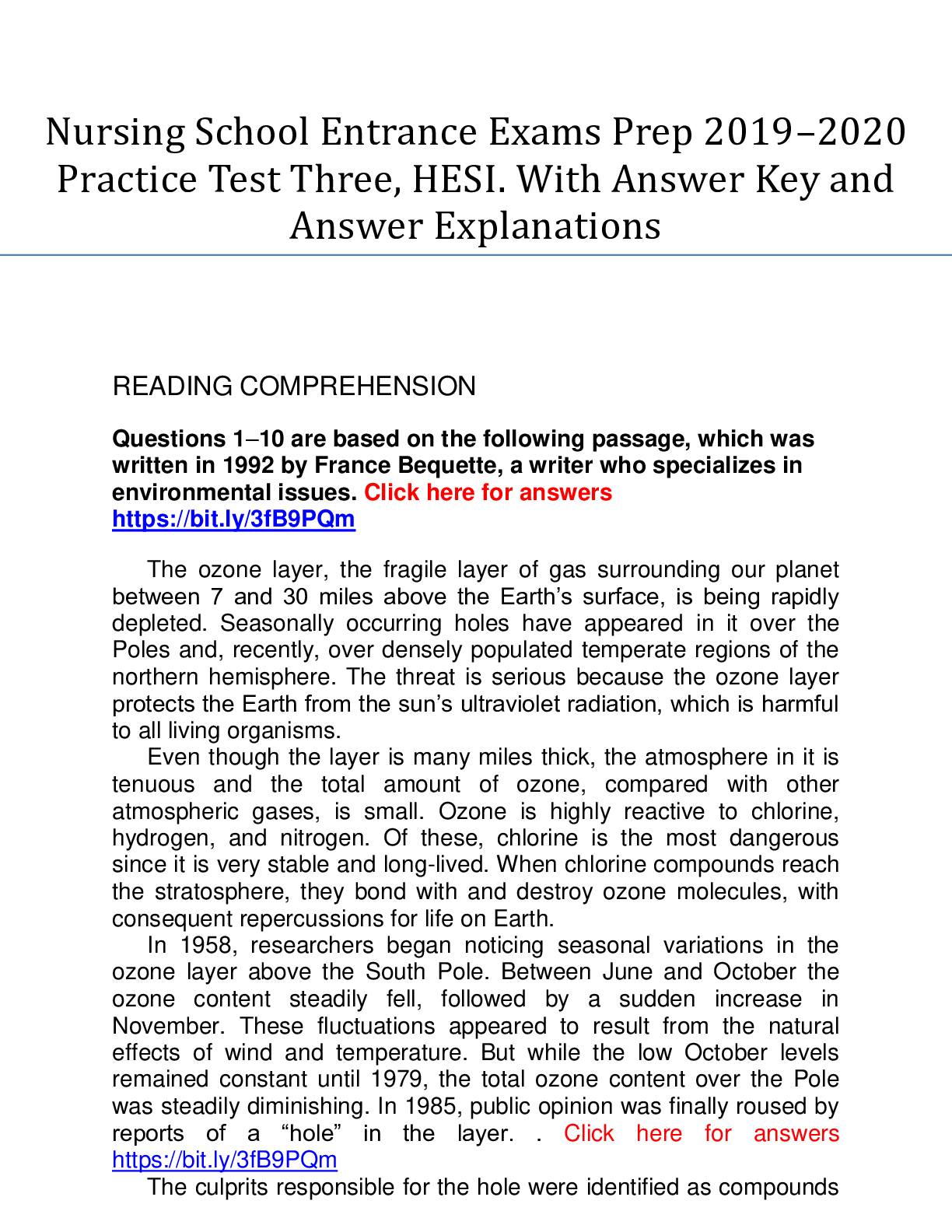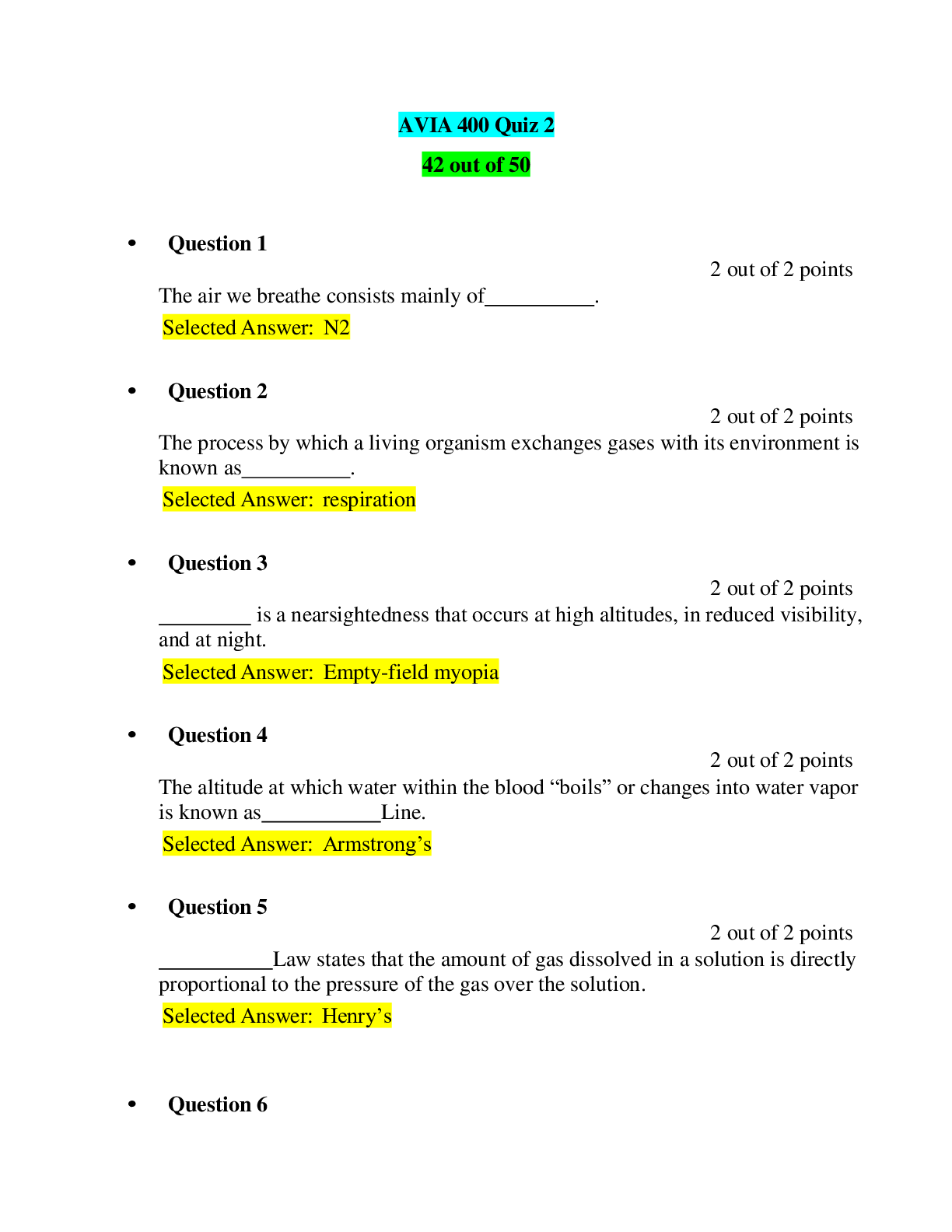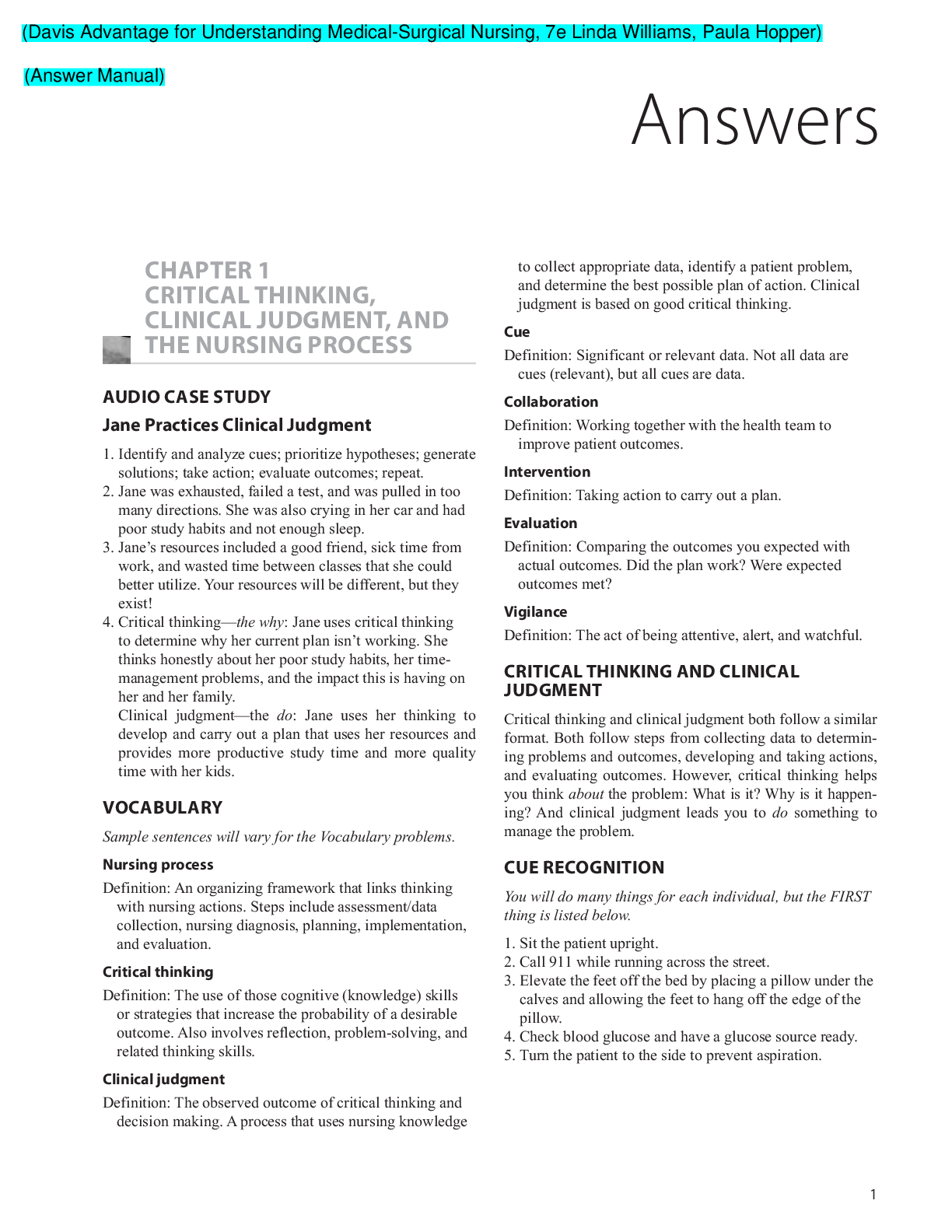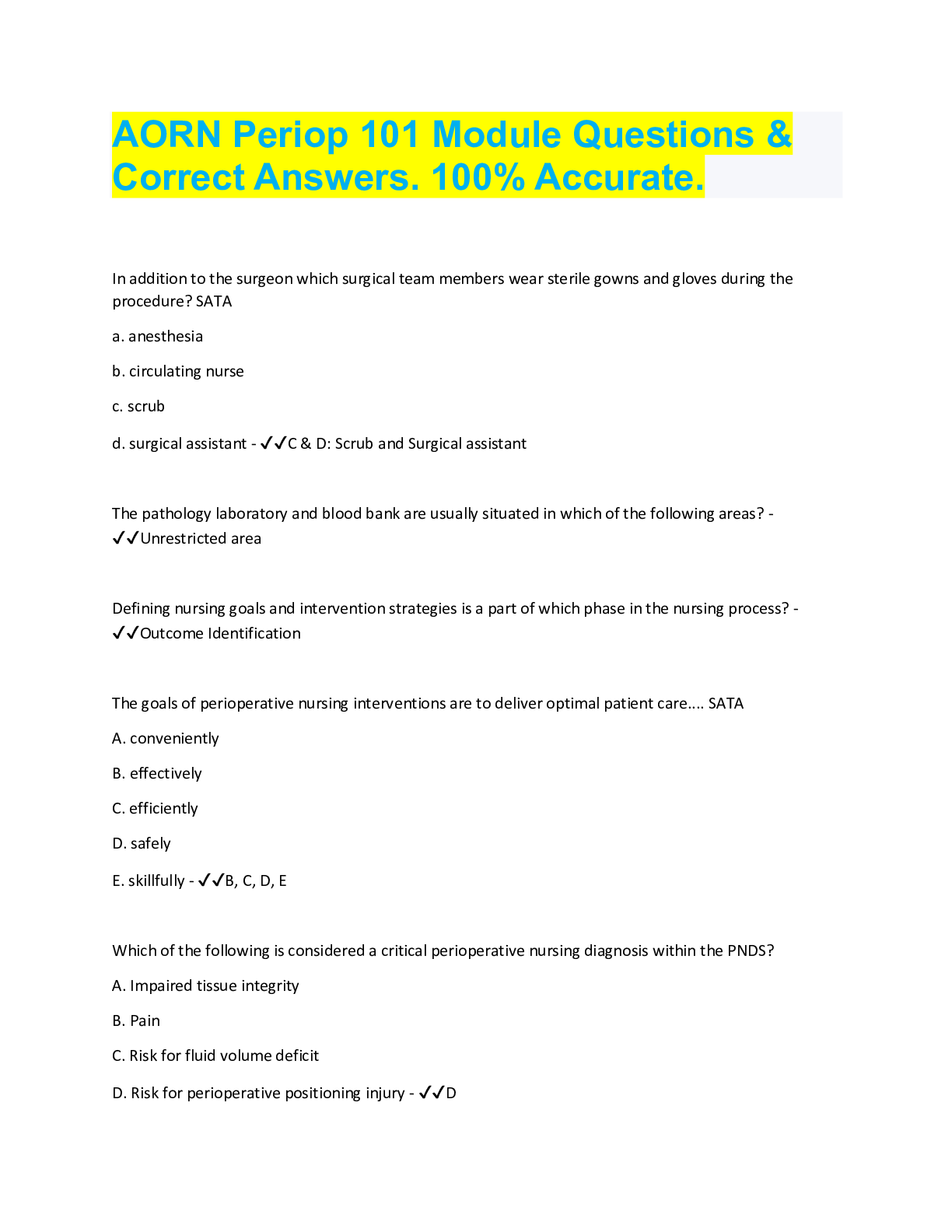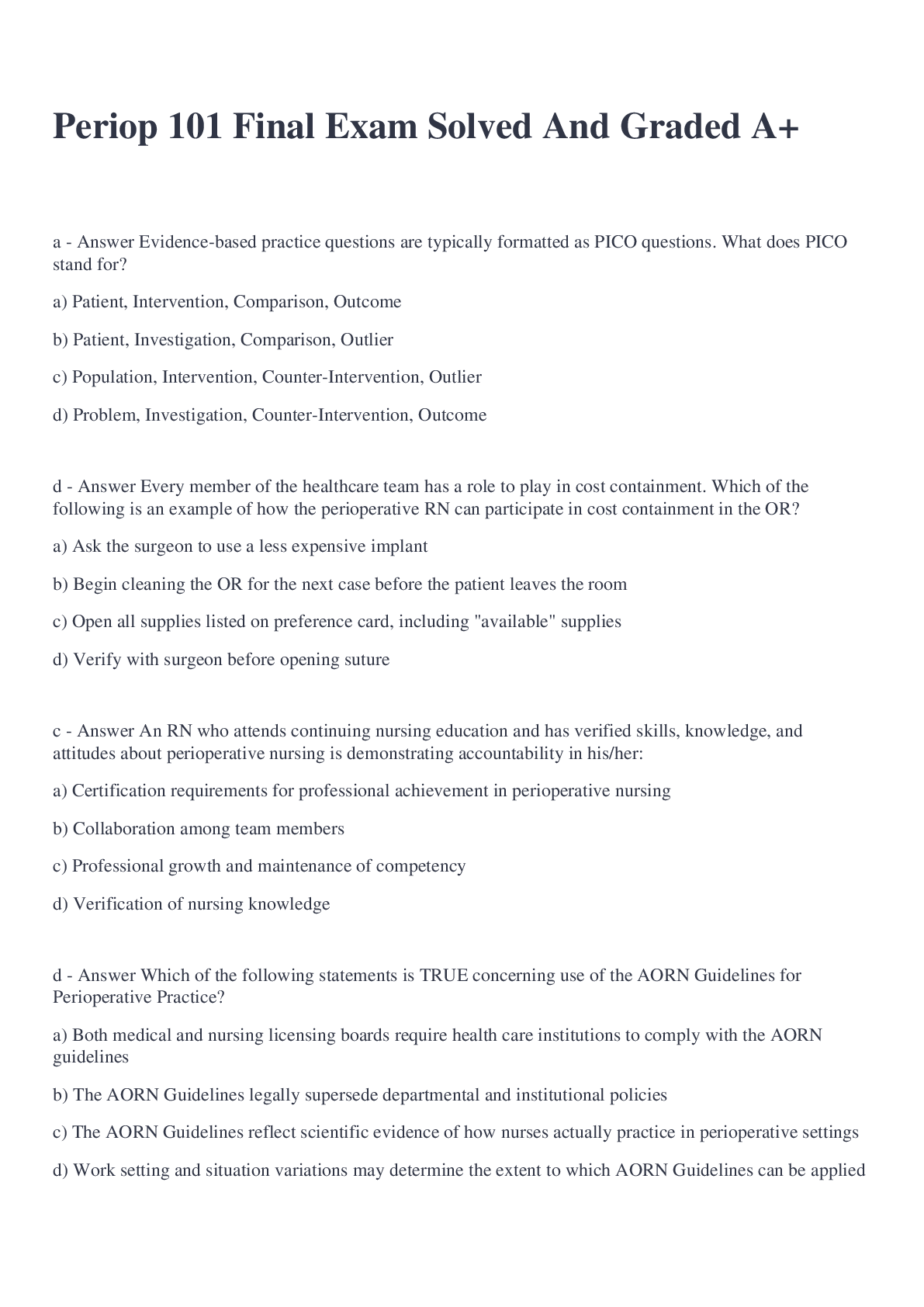*NURSING > QUESTIONS & ANSWERS > Nursing School Entrance Exams Prep 2019–2020 Practice Test Four, HESI. With Answer Key and Answer (All)
Nursing School Entrance Exams Prep 2019–2020 Practice Test Four, HESI. With Answer Key and Answer Explanations
Document Content and Description Below
Nursing School Entrance Exams Prep 2019–2020 Practice Test Four, HESI READING COMPREHENSION Questions 1–10 are based on the following passage. In a world where modern technology can render cert... ain jobs—such as switchboard operator—obsolete, some economic scholars have looked at ways to ensure that such workers are not left behind. One idea that has enjoyed increasing popularity, and has also generated controversy, is the idea of a universal basic income. A universal basic income is a guaranteed base dividend, paid to every eligible citizen, regardless of whether or not they hold a job. The idea of a universal basic income dates back at least until the eighteenth century. In 1796, British reformist Thomas Spence called for all profits from lands and rent to be redistributed among “all the living souls in the parish,” calling such redistribution “the imprescriptible right of every human being in civilized society.” At the same time in the United States, activist Thomas Paine called for landowners to be taxed as a way of providing funds for those with no land. Both ideas share some similarity with modern ideas of social welfare programs. In the early twentieth century, British reformers like Clifford Douglas and Dennis Milner renewed calls for a basic income. Supporters of a universal basic income argue that it could alleviate many of the problems of the poorest citizens, and in so doing, benefit all citizens. For example, studies have shown that low-income citizens are, by necessity, more likely to spend any money they receive on goods and services, such as food, clothing, or rent. This type of spending contributes directly to economic growth. Wealthier citizens, by contrast, spend a comparatively smaller amount of their money on goods and services. Advocates also point to the simplicity of a universal basic income, noting that it is more efficient and transparent than the patchwork of means-tested social welfare programs that currently exist in many countries. In addition, a guaranteed basic income would eliminate the stigmatization of those receiving welfare benefits and services. Critics of a universal basic income argue against the notion from several different angles. Some argue that such an income would cause citizens to become “lazy,” though studies of pilot programs have not supported this idea. Critics also argue that giving out free money to poor people would simply allow them to waste it on things like alcohol or drugs—again, without supporting evidence from pilot program studies. In addition, if a single country were to approve a basic universal income, it might become flooded with immigrants hoping to take advantage of the new system. From an economic perspective, some critics have expressed concern that giving away free money would simply increase inflation, so that the price of goods would rise to absorb the additional money being supplied to citizens. In the United States, the idea of a basic income has been characterized as “anti-capitalist” and an affront to the strong work ethic that defines the nation. Although the efficacy of a universal basic income remains open to debate, the debate itself is gaining more attention around the world. In the United States, where wealth inequality is at its highest level since the 1920s, some lawmakers have voiced their support for the idea despite its controversial nature. Some high-profile technology executives have predicted that the issue will become more urgent as automation technology takes the place of more and more human workers. In 2017, Finland began a two-year trial program where it gave 2,000 unemployed people a basic income. When the results from Finland are finally published in 2019, perhaps the critics will discover that a universal basic income is not something to fear, but something to embrace. 1. Which is the main idea of the second paragraph? (A) The earliest support for a universal basic income came from British reformists. (B) The idea of a universal basic income has been around for over 200 years. (C) Thomas Paine brought the idea of a universal basic income to the United States. (D) Although some fringe intellectuals have supported a universal basic income, the idea has never enjoyed mainstream support. 2. Which is the meaning of the word obsolete as used in the second paragraph? (A) Ignored. (B) Without success. (C) No longer needed. (D) Unable to prepare. 3. Which answer option is not listed as a detail in the passage? (A) Spending on goods and services directly contributes to economic growth. (B) Thomas Spence wrote about universal basic income in 1796. (C) Clifford Douglas and Dennis Milner were twentieth-century British reformers. (D) Finland provided nearly $700 per month to citizens in its basic income trial. 4. Which answer option represents the best summary of the passage? (A) A universal basic income is money given to all citizens without any conditions on its use, and the idea has been around for centuries. (B) The arguments in favor of a universal basic income include: a more streamlined and efficient way to provide support to citizens; greater economic growth through spending on goods and services; and less stigmatization of the poor. (C) The idea of a universal basic income, or a sum of money given without conditions to all citizens, remains controversial but could play an important part in future discussions about employment in an increasingly automated workforce. (D) A universal basic income, given out to every citizen even if they do not work, would allow people to become lazy, spend government-provided money on indulgences like alcohol, and erode the longstanding value of a work ethic. 5. Why does the author mention wealthier citizens in the third paragraph? (A) To illustrate how lower-income citizens can become wealthy. (B) To contrast their spending with the spending of lower-income citizens. (C) To explain how wealth transfers between individuals. (D) To argue that wealthy people do not deserve to keep their money. 6. Which is the author’s primary purpose in writing this piece? (A) To examine the pros, cons, and possible future impact of a universal basic income. (B) To provide a comprehensive definition of universal basic income for the reader. (C) To argue that eighteenth-century activists should be given credit for coming up with the idea of a universal basic income. (D) To entertain the reader with anecdotes about how universal basic income has been viewed through the years. 7. Which answer option is an opinion? (A) The idea of a universal basic income dates back until at least the eighteenth century. (B) Studies have shown that low-income citizens are, by necessity, more likely to spend any money they receive on goods and services, such as food, clothing, or rent. (C) In the United States, where wealth inequality is at its highest level since the 1920s, some lawmakers have voiced their support for the idea despite its controversial nature. (D) When the results from Finland are finally published in 2019, perhaps the critics will discover that a universal basic income is not something to fear, but something to embrace. 8. Which detail supports the idea that the concept of universal basic income is becoming more widely accepted? (A) Finland launched a two-year trial in 2017 to gauge the effects of a universal basic income. (B) Inequality in the United States has reached its highest levels since the 1920s. (C) British reformers in the early twentieth century pushed for a basic income. (D) Automation technology threatens the jobs of an unknown percentage of the workforce. 9. Based on the final sentence of the passage, which statement can be inferred about the author’s views on universal basic income? (A) The author thinks a universal basic income will not be necessary due to increasing automation technology. (B) The author thinks that the results from the Finland trial will not offer conclusive support for either side of the issue. (C) The author supports a universal basic income. (D) The author does not support a universal basic income. 10. Which is the meaning of the word efficacy as used in the fifth paragraph? (A) Likelihood. (B) Future. (C) Concept. (D) Effectiveness. VOCABULARY 1. Select the meaning of the underlined word in the sentence. Tests revealed that the patient’s hearing was severely impaired by the accident. (A) Diminished. (B) Affected. (C) Sensitized. (D) Made irregular. 2. Select the meaning of the underlined word in the sentence. The nurse discovered an occlusion in the patient’s central venous catheter. (A) Toxin. (B) Blockage. (C) Defect. (D) Hole. 3. Which is the best definition of the word abrupt? (A) Sudden. (B) Terminal. (C) Unpredictable. (D) Explosive. 4. Select the meaning of the underlined word in the sentence. The quarterly report on communicable diseases was surprisingly succinct and easy to understand. (A) Entertaining. (B) Cursory. (C) Comprehensive. (D) Concise. 5. Which word meaning “took into the body” best fits in the sentence? The patient with stomach pain reported that he had approximately 50 paper clips. (A) Egested. (B) Congested. (C) Ingested. (D) Digested. 6. Select the meaning of the underlined word in the sentence. The patient’s electrolyte imbalance suggested that he was suffering from acute kidney injury. (A) Early. (B) Severe. (C) Sensitive. (D) Likely. 7. Which is the best definition of the word precipitous? (A) Covered in moisture. (B) Without evidence. (C) Extremely steep. (D) Very high. 8. Which word meaning “cause of a disease” best fits in the sentence? By studying the circumstances surrounding each patient’s infection, the doctor was able to theorize about the of the outbreak. (A) Histology. (B) Logy. (C) Chronology. (D) Etiology. 9. Which is the best definition of the word assent? (A) Climb. (B) Delivery. (C) Agreement. (D) Denial. 10. Which word meaning “omnipresent” best fits in the sentence? One of the biggest technological advancements in nursing is the rise of computing in the care environment. (A) Eponymous. (B) Ubiquitous. (C) Analogous. (D) Synchronous. GRAMMAR 1. Which sentence is grammatically incorrect? (A) Whether or not the needle had been used, the fact that it had been opened was enough to warrant its disposal. (B) The safety inspector declared that there were to many people gathered in the satellite waiting area. (C) She and I were equally alarmed by the presence of the armed officers in the room. (D) Please go to the fourth floor and pick up the results of the blood panel. 2. Select the best word for the blank in the following sentence. The map that shows the emergency exits on all floors of the hospital incorrect and should be reprinted. (A) Are. (B) Is. (C) Have been. (D) Were. 3. Which word is used incorrectly in this sentence? Neither the doctor or the nurse was able to determine what happened to the three patients’ blood samples. (A) Or. (B) Was. (C) What. (D) Patients’. 4. Which sentence is grammatically incorrect? (A) Both of the nursing school students were surprised by the number of different medications that they were required to know. (B) In the event of a fire, please proceed to the nearest marked exits. (C) For Shahir, turning in an incomplete answer sheet was the same as giving up. (D) He found that memorizing the names of bones in the human body was far more harder than learning the stages of the cardiac cycle. 5. Which word in the sample sentence is a pronoun? The tired trainees all left their notebooks at the front desk during lunch. (A) Tired. (B) All. (C) Their. (D) During. 6. Which word is used incorrectly in this sentence? The authorities had some difficulty establishing to who the mysterious package was addressed. (A) Had. (B) Establishing. (C) Who. (D) Was. 7. Which word from the sample sentence is a participle? The three researchers decided to have a working lunch and discuss their findings. (A) Three. (B) Decided. (C) Working. (D) Findings. 8. Which sentence contains a cliché? (A) Although Jeff did not want to lose his job, the writing was on the wall after he failed to complete his safety certification. (B) After the accident, the passenger in the back seat had to remain hospitalized for much longer than the driver. (C) The elderly swimmer was able to complete the race more quickly than some swimmers who were forty years younger. (D) Matthijs missed his work shift because his dog swallowed a sock and had to be taken to the veterinary clinic. 9. Select the best word for the blank in the following sentence. Ellen playing the trumpet since she was 10 years old. (A) Been. (B) Has been. (C) Have been. (D) Is. 10. Which word from the sample sentence is a conjunction? She took her break while the wing was relatively quiet, knowing it would be difficult to take one later. (A) While. (B) Knowing. (C) Would. (D) Later. MATHEMATICS 1. Solve for x: 5(x − 2) = 3x + 6 (A) −4 (B) 4 (C) 8 (D) 12 2. Convert the following 12-hour clock time to military time: 2:17:08 PM (A) 02:17:08 hours (B) 12:17:08 hours (C) 14:17:08 hours (D) 15:17:08 hours 3. Which is written as a percent? (A) 76% (B) 80% (C) 82.5% (D) 87.5% 4. Which is 5% of 10% of 200? (A) 0.1 (B) 0.5 (C) 1 (D) 2 5. The number 12 is 30% of what number? (A) 30 (B) 32 (C) 36 (D) 40 6. Which option is 0.6 expressed as a fraction? (A) (B) (C) (D) 7. What is ? (A) (B) (C) (D) 8. What is ? (A) (B) (C) (D) 9. Which is expressed as a ratio? (A) 5:6 (B) 5:9 (C) 3:4 (D) 2:3 10. If x = 8, y = 0.3, and z = 1.5, what is the value of the expression (4 − x)2 − 8y + 2(z + 3)? (A) 22.6 (B) 1 (C) −9.4 (D) −12 BIOLOGY 1. Which is not a characteristic of water? (A) High specific heat value. (B) Strong polarity that facilitates intermolecular bonds. (C) Ability to dissolve many substances. (D) Very low adhesion. 2. Which term describes an individual who carries two different alleles for a specific gene? (A) Dominant. (B) Recessive. (C) Heterozygous. (D) Homozygous. 3. Which of these is not a lipid? (A) Fatty acids. (B) Amino acids. (C) Steroids. (D) Phospholipids. 4. Which organelle is chiefly responsible for respiration and energy production? (A) Golgi apparatus. (B) Endoplasmic reticulum. (C) Mitochondrion. (D) Nucleus. 5. Which substance is a product of photosynthesis? (A) Glucose. (B) Water. (C) Carbon dioxide. (D) Photons. CHEMISTRY 1. Which value does the scientific notation 8.323 × 105 represent? (A) 0.00008323 (B) 83,230 (C) 832,300 (D) 8,323,000 2. Which temperature is equivalent to 273K (273 degrees Kelvin)? (A) 0 degrees Fahrenheit. (B) 0 degrees Celsius. (C) 100 degrees Celsius. (D) 212 degrees Fahrenheit. 3. Which particles are found in the nucleus of an atom? (A) Protons and neutrons. (B) Protons and electrons. (C) Neutrons and electrons. (D) Protons, neutrons, and electrons. 4. Which are the products in the following chemical reaction? C3H8 + 5 O2 → 3 CO2 + 4 H2O (A) Propane and oxygen. (B) Carbon and hydrogen. (C) Oxygen and hydrogen. (D) Water and carbon dioxide. 5. Which type of chemical reaction involves the breaking down of a compound into its component elements? (A) Synthesis. (B) Decomposition. (C) Combustion. (D) Single replacement. ANATOMY AND PHYSIOLOGY 1. Which body plane cuts horizontally through the midsection? (A) Frontal plane. (B) Sagittal plane. (C) Transverse plane. (D) Median plane. 2. Which term is not a section of the vertebral column? (A) Lumbar. (B) Sacral. (C) Thoracic. (D) Cranial. 3. Which of these connects the pituitary gland to the hypothalamus? (A) Adrenal cortex. (B) Infundibulum. (C) Adenohypophysis. (D) Neurohypophysis. 4. The male and female sex organs in humans undertake which function? (A) Production of gametes. (B) Production of hormones. (C) Both A and B. (D) None of the above. 5. Where does gas exchange take place in the respiratory system? (A) Bronchi. (B) Trachea. (C) Alveoli. (D) Larynx. PHYSICS 1. A train travels 9.2 kilometers over a period of 3 minutes and 50 seconds. Which is the average speed of the train? (A) 0.4 m/s (B) 2.1 m/s (C) 4 m/s (D) 40 m/s 2. A toy car is rolled down a hill. Its initial speed is 0.4 m/s, and it travels down the hill for 1 minute. At the end of 1 minute, the car’s speed is 8.2 m/s. Which is the magnitude of the car’s acceleration? (A) 0.13 m/s2 (B) 0.26 m/s2 (C) 2.6 m/s2 (D) 7.8 m/s2 3. Which of these is another way of expressing 14N (14 newtons of force)? (A) 14 m/s (B) 14 m/s2 (C) 14 kg-m/s2 (D) 14 net m/s2 4. A spinning wheel accelerates from 3 revolutions per second to 15 revolutions per second over a period of 1 minute. Which is the angular acceleration of the wheel? (A) 0.2 revolutions/s2 (B) 2 revolutions/s2 (C) 4 revolutions/s2 (D) 12 revolutions/s2 5. A storage cart has a mass of 600 kg and is traveling at a speed of 5 m/s. How much kinetic energy does the cart have as a result of its motion? (A) 1,200 J (B) 7,500 J (C) 12,000 J [Show More]
Last updated: 1 year ago
Preview 1 out of 32 pages
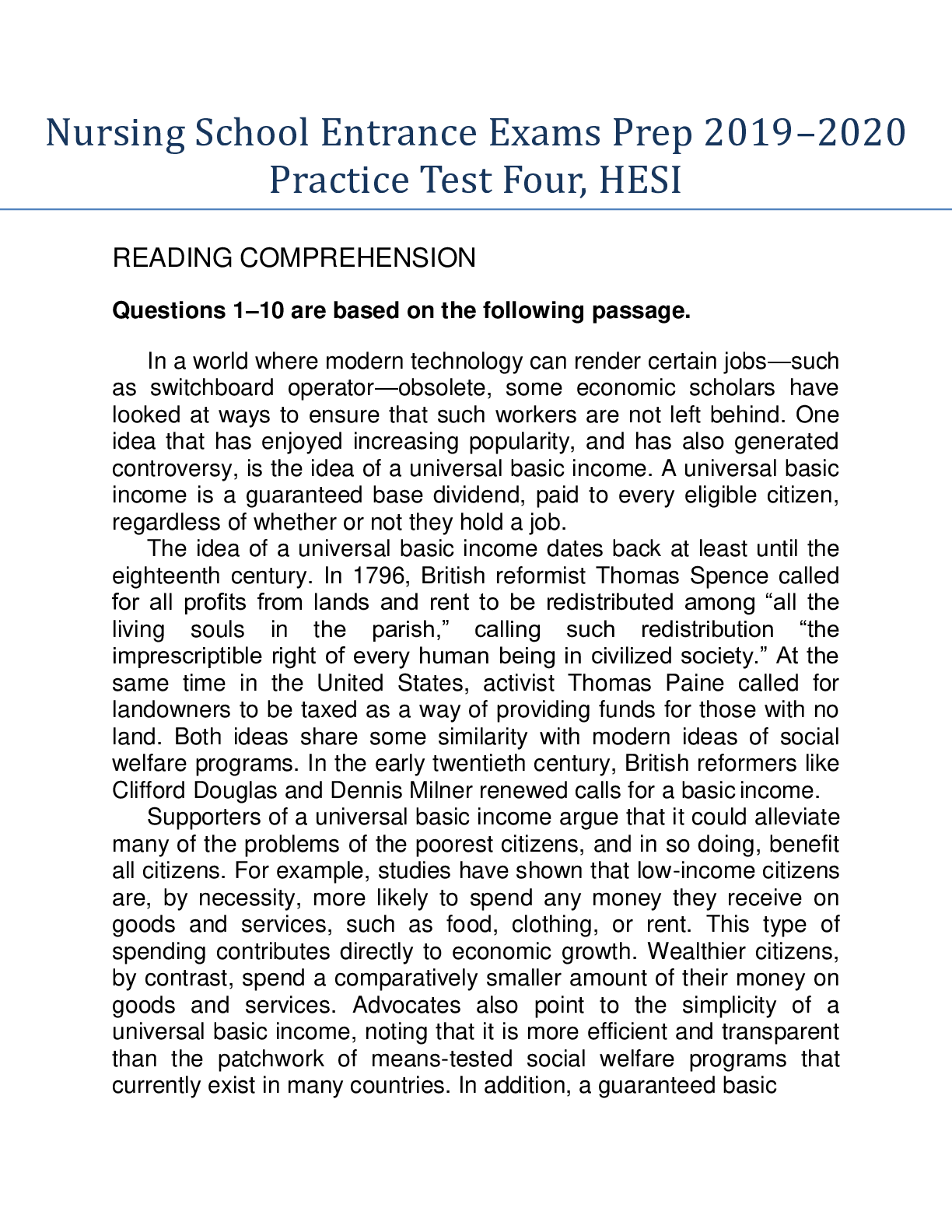
Reviews( 0 )
Document information
Connected school, study & course
About the document
Uploaded On
Jun 18, 2020
Number of pages
32
Written in
Additional information
This document has been written for:
Uploaded
Jun 18, 2020
Downloads
0
Views
71















